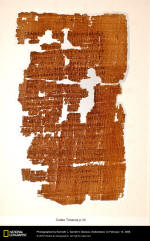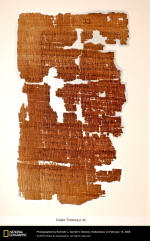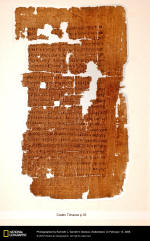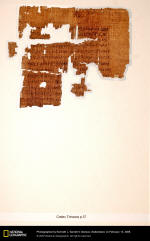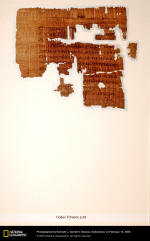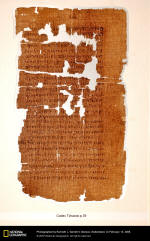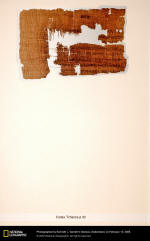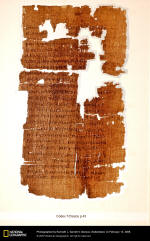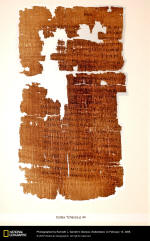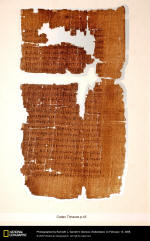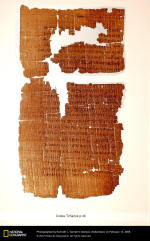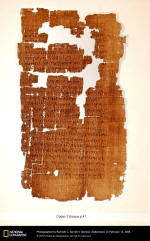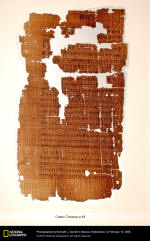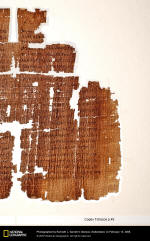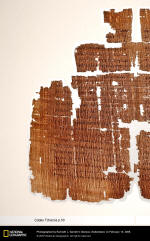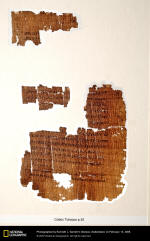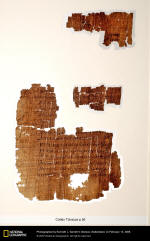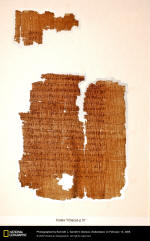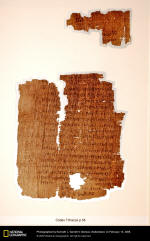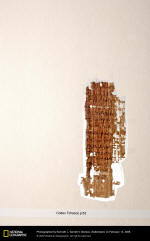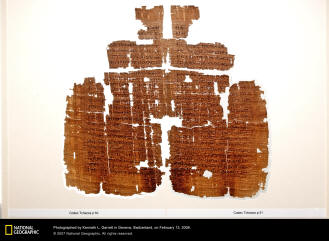|

2006
from
NationalGeographic Website
Recovered through
WayBackMachine Website
An ancient Coptic manuscript dating from
the third or fourth century, containing the only known surviving
copy of the Gospel of Judas, has been restored and authenticated
after being lost for nearly 1,700 years.
In order to be certain of its age and authenticity, the National
Geographic Society put the codex through the closest scrutiny
possible without doing it harm.
This included submitting minute
samples of the papyrus to a rigorous radiocarbon-dating process,
analyzing the ink, submitting the manuscript to multispectral
imaging, and consulting with leading scholars well-versed in the
fields of paleography and codicology.
The National Geographic Society collaborated with the
Maecenas Foundation for Ancient Art and the Waitt Institute
for Historical Discovery.
Rodolphe Kasser, of Switzerland,
one of the world's preeminent Coptic scholars, was recruited to
restore the text, transcribe it, and translate the manuscript, which
contains not only the Gospel of Judas, but also a text called
James, the Letter of Peter to Philip, and a fragment
of a text that scholars are provisionally calling Book of
Allogenes.
During the first centuries A.D., in a
constantly shifting political environment church leaders shaped the
New Testament around four chosen Gospels.
But divergent beliefs
jostled for prominence in Christian thought. In recent decades
long-lost chronicles have been found, originally hidden during those
turbulent times.
Such manuscripts describe a world of
ideas that has been lost to us for nearly 1,700 years.
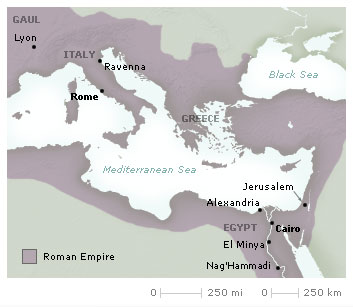
Frequently
Asked Questions
What is a codex, and why is this
document called the Codex Tchacos?
A codex is an ancient book consisting of folded pages, bound at
one side. Codices were the preferred form for scriptural or
classical texts, as they could contain a lot more information
than scrolls and were easier to manage. Codex Tchacos is
named after Dimaratos Tchacos, father of Zόrich-based
antiquities dealer Frieda Nussberger-Tchacos, who bought
the document in September 2000.
What does the Codex Tchacos contain?
The codex contains not only the Gospel of Judas, but also a text
titled James (otherwise known as the First Apocalypse of James),
the Letter of Peter to Philip, and a fragment of a text that
scholars are provisionally calling Book of Allogenes.
Where was the Codex Tchacos discovered?
The codex, containing the Gospel of Judas, was discovered in the
1970s near El Minya, Egypt, and moved from Egypt to Europe to
the United States. Once in the United States, it was kept in a
safe-deposit box for 16 years on Long Island, New York, until
antiquities dealer Frieda Nussberger-Tchacos bought it in April
2000.
After two unsuccessful resale
attempts, Nussberger-Tchacos - alarmed by the codex's rapidly
deteriorating state - transferred it to the Maecenas Foundation
for Ancient Art in Basel, Switzerland, in February 2001, for
restoration and translation. The manuscript will be delivered to
Egypt and housed in Cairo's Coptic Museum.
How did the codex containing the Gospel of Judas survive for
so many centuries?
Because the Gospel of Judas was hidden in the Egyptian desert
for more than 1,600 years, the papyrus remained intact. However,
the document severely deteriorated when it was kept in a
safe-deposit box on Long Island, New York, for 16 years.
As a result, the conservation
process to rescue and preserve the manuscript has been an
enormous undertaking, as Rodolphe Kasser and his team
worked to piece the document back together by reassembling
nearly a thousand broken fragments of papyrus.
What is the history of the codex containing the Gospel of
Judas?
The National Geographic Society has worked with a team of
international experts to analyze a collection of ancient papyrus
documents, which include the Gospel of Judas, first
discovered more than 30 years ago in Egypt. The rare religious
texts in the codex are written in the ancient Egyptian Coptic
language and are about 1,700 years old.
National Geographic collaborated
with the Waitt Institute for Historical Discovery, the
Maecenas Foundation for Ancient Art, and scientific experts,
historians, and theologians from around the world to
authenticate, reconstruct, conserve, and translate these
extraordinary documents, and explore their significance.
Was the Gospel of Judas known to scholars?
Scholars knew of the existence of the Gospel of Judas
because of references in other ancient texts. The oldest known
reference to a Gospel of Judas is by Irenaeus, Bishop of
Lyon, in A.D. 180. However, this codex containing the Gospel
of Judas was not discovered until the 1970s in Egypt,
and it wasn't until 2001 that a team led by Professor
Rodolphe Kasser of Switzerland, a world-renowned Coptic
scholar, began to translate and conserve the ancient text.
Who wrote the Gospel of Judas?
The author of the Gospel of Judas remains anonymous. The
original Greek text of the gospel, of which this is a Coptic
translation, is thought to have been written by a group of early
gnostic Christians sometime between when the New
Testament Gospels of Matthew, Mark, Luke, and John were
penned and A.D. 180.
Why were these early texts developed? What was their purpose?
Different groups of Christians in the second century appealed to
different writings to authenticate their distinctive beliefs and
practices. Numerous gospels appeared, often written in the names
of the Apostles; these pseudonymous writings were revered as
scripture by one group or another, although eventually most of
them came to be labeled as "heretical" and proscribed by
orthodox Christianity in later times.
What does the publication of this text mean for Christian
teachings?
This is a dramatic archaeological discovery of cultural
interest, which offers an alternate portrayal from the first or
second century of the relationship between Jesus and
Judas, and enhances our knowledge of history and
preservation of theological viewpoints from that period.
National Geographic realizes that the information provided by
this document is complex and deserves a great deal of further
study and assessment, a process that will take time.
How did National Geographic get involved in the project?
The document changed hands a number of times following its
discovery. The Maecenas Foundation for Ancient Art in
Switzerland approached National Geographic to play a key
role in the authentication and conservation of the codex.
National Geographic gathered numerous experts to bring the
project to completion. After conservation is complete and the
codex has been exhibited to the public, the codex will be given
to Egypt, where it will be housed in Cairo's Coptic Museum.
Why has National Geographic decided to get involved in a
project of this type?
The codex that contains the Gospel of Judas is the most
significant discovery of ancient, non-biblical Christian or
Jewish texts of the last 60 years. Because of National
Geographic's commitment to discovery and conservation of
artifacts that support the study of ancient culture and enhance
historical knowledge, the Society felt compelled to take part in
the rescue of this ancient document.
Why did it take so long to publish?
Because the manuscript had deteriorated so badly during the past
30 years, restoring, conserving, and translating its text has
been an enormous undertaking. Compared with the length of time
it took to conserve, translate and publish the
Nag Hammadi manuscripts (about
25 years) and the
Dead Sea Scrolls (about 50
years), the publication process of the Gospel of Judas,
which has taken just five years, has been quite an expedited
one.
What was the translation process and who was involved?
The Maecenas Foundation for Ancient Art recruited
Professor Rodolphe Kasser of Switzerland, one of the
world's leading Coptic scholars, to lead an international team
of scholars, translators, scientists, archaeologists, and
historians to translate the document.
How was the artifact, known as the Gospel of Judas, restored?
This was a daunting process, because the document's condition
had deteriorated significantly over the last two decades. Kasser
enlisted the help of papyrus conservator Florence Darbre
of Switzerland and Coptic scholar Gregor Wurst of the
University of Augsburg, Germany, to piece together the 26-page
Gospel of Judas.
With the help of computer programs
that record text, register gaps and try to match gaps to text,
and with careful, visual inspection of suggested matches to
confirm papyrus fiber continuity, Darbre, Wurst, and Kasser have
been able to reassemble more than 80 percent of the text in five
painstaking years.
How was authenticate the document?
The codex has been authenticated as a genuine work of ancient
Christian apocryphal literature on five fronts: radiocarbon
dating, ink analysis, multispectral imaging, contextual
evidence, and paleographic evidence.
The Gospel of Judas
Translated by Rodolphe
Kasser, Marvin Meyer, and Gregor Wurst
in collaboration with Franηois
Gaudard
extracted from The Gospel
of Judas
Edited by Rodolphe Kasser, Marvin Meyer, and Gregor Wurst
2006
Click title for source...
|
The National Geographic
Society has been part of an international effort, in
collaboration with the Maecenas Foundation for Ancient
Art and the Waitt Institute for Historical Discovery, to
authenticate, conserve, and translate a 66-page codex,
which contains a text called James (also known as First
Apocalypse of James), the Letter of Peter to Philip, a
fragment of a text that scholars are provisionally
calling Book of Allogenes, and the only known surviving
copy of the Gospel of Judas.
The Gospel of Judas gives a different view of the
relationship between Jesus and Judas, offering new
insights into the disciple who betrayed Jesus. Unlike
the accounts in the canonical Gospels of Matthew, Mark,
Luke, and John, in which Judas is portrayed as a reviled
traitor, this newly discovered Gospel portrays Judas as
acting at Jesus' request when he hands Jesus over to the
authorities. |
INTRODUCTION:
INCIPIT
The secret account of the revelation that Jesus spoke in
conversation with Judas Iscariot during a week three days before he
celebrated Passover.
THE EARTHLY MINISTRY
OF JESUS
When Jesus appeared on earth, he performed miracles and great
wonders for the salvation of humanity. And since some [walked] in
the way of righteousness while others walked in their
transgressions, the twelve disciples were called.
He began to speak with them about the mysteries beyond the world and
what would take place at the end. Often he did not appear to his
disciples as himself, but he was found among them as a child.
SCENE 1:
Jesus dialogues with his disciples: The
prayer of thanksgiving or the eucharist.
One day he was with
his disciples in Judea, and he found them gathered together and
seated in pious observance. When he [approached] his disciples, [34]
gathered together and seated and offering a prayer of thanksgiving
over the bread, [he] laughed.
The disciples said to [him],
"Master, why are you
laughing at [our] prayer of thanksgiving? We have done what is
right."
He answered and said to them,
"I am not laughing at
you. <You> are not doing this because of your own will but
because it is through this that your god [will be] praised."
They said, "Master,
you are [
] the son of our god."
Jesus said to them,
"How do you know me? Truly [I] say to you, no generation of the
people that are among you will know me."
THE DISCIPLES BECOME
ANGRY
When his disciples heard this, they started getting angry and
infuriated and began blaspheming against him in their hearts.
When Jesus observed their lack of [understanding, he said] to them,
"Why has this
agitation led you to anger? Your god who is within you and [
]
[35] have provoked you to anger [within] your souls. [Let] any
one of you who is [strong enough] among human beings bring out
the perfect human and stand before my face."
They all said, "We
have the strength."
But their spirits did not dare to stand
before [him], except for Judas Iscariot. He was able to stand before
him, but he could not look him in the eyes, and he turned his face
away.
Judas [said] to him,
"I know who you are and where you
have come from. You are from the immortal realm of Barbelo. And
I am not worthy to utter the name of the one who has sent you."
JESUS SPEAKS TO JUDAS
PRIVATELY
Knowing that Judas was reflecting upon something that was exalted,
Jesus said to him,
"Step away from the
others and I shall tell you the mysteries of the kingdom. It is
possible for you to reach it, but you will grieve a great deal.
[36] For someone else will replace you, in order that the twelve
[disciples] may again come to completion with their god."
Judas said to him, "When will you tell me these things, and
[when] will the great day of light dawn for the generation?"
But when he said this, Jesus left him.
SCENE 2:
Jesus appears to the disciples again.
The next morning, after this happened, Jesus [appeared] to his
disciples again.
They said to him,
"Master, where did
you go and what did you do when you left us?"
Jesus said to them, "I went to another great and holy
generation."
His disciples said to him,
"Lord, what is the great generation that is superior to us and
holier than us, that is not now in these realms?"
When Jesus heard this, he laughed and
said to them,
"Why are you thinking in your hearts
about the strong and holy generation? [37] Truly [I] say to you,
no one born [of] this aeon will see that [generation], and no
host of angels of the stars will rule over that
generation, and no person of mortal birth can associate with it,
because that generation does not come from [
] which has become
[
]. The generation of people among [you] is from the generation
of humanity [
] power, which [
the] other powers [
] by [which]
you rule."
When [his] disciples heard this, they
each were troubled in spirit. They could not say a word.
Another day Jesus came up to [them]. They said to [him],
"Master, we have seen
you in a [vision], for we have had great [dreams
] night [
]."
[He
said], "Why have [you
when] <you> have gone into hiding?" [38]
THE DISCIPLES SEE THE
TEMPLE AND DISCUSS IT
They [said, "We have
seen] a great [house with a large] altar [in it, and] twelve men
- they are the priests, we would say - and a name; and a crowd
of people is waiting at that altar, [until] the priests [
and
receive] the offerings. [But] we kept waiting."
[Jesus said], "What
are [the priests] like?"
They [said, "Some
] two weeks; [some] sacrifice their own
children, others their wives, in praise [and] humility with each
other; some sleep with men; some are involved in [slaughter];
some commit a multitude of sins and deeds of lawlessness. And
the men who stand [before] the altar invoke your [name], [39]
and in all the deeds of their deficiency, the sacrifices are
brought to completion [
]."
After they said this, they were quiet,
for they were troubled.
JESUS OFFERS AN
ALLEGORICAL INTERPRETATION OF THE VISION OF THE TEMPLE
Jesus said to them,
"Why are you
troubled? Truly I say to you, all the priests who stand before
that altar invoke my name. Again I say to you, my name has been
written on this [
] of the generations of the stars through the
human generations. [And they] have planted trees without fruit,
in my name, in a shameful manner."
Jesus said to them,
"Those you have seen receiving the
offerings at the altar - that is who you are. That is the god you
serve, and you are those twelve men you have seen. The cattle
you have seen brought for sacrifice are the many people you lead
astray [40] before that altar. [
] will stand and make use of my
name in this way, and generations of the pious will remain loyal
to him.
After him another man will stand
there from [the fornicators], and another [will] stand there
from the slayers of children, and another from those who sleep
with men, and those who abstain, and the rest of the people of
pollution and lawlessness and error, and those who say, We are
like angels'; they are the stars that bring everything to its
conclusion. For to the human generations it has been said,
Look, God has received your sacrifice from the hands of a
priest' - that is, a minister of error. But it is the Lord, the
Lord of the universe, who commands, On the last day they will
be put to shame.'" [41]
Jesus said [to them],
"Stop sac[rificing
] which you have
[
] over the altar, since they are over your stars and your
angels and have already come to their conclusion there. So let
them be [ensnared] before you, and let them go [ - about 15 lines
missing - ] generations [
]. A baker cannot feed all creation [42]
under [heaven]. And [
] to them [
] and [
] to us and [
].
Jesus said to them,
"Stop struggling with
me. Each of you has his own star, and every[body - about 17
lines missing - ] [43] in [
] who has come [
spring] for the
tree [
] of this aeon [
] for a time [
] but he has come to
water God's paradise, and the [generation] that will last,
because [he] will not defile the [walk of life of] that
generation, but [
] for all eternity."
JUDAS ASKS JESUS
ABOUT THAT GENERATION AND HUMAN GENERATIONS
Judas said to [him, "Rabb]i,
what kind of fruit does this generation produce?"
Jesus said,
"The souls of every
human generation will die. When these people, however, have
completed the time of the kingdom and the spirit leaves them,
their bodies will die but their souls will be alive, and they
will be taken up."
Judas said, "And what
will the rest of the human generations do?"
Jesus said,
"It is impossible
[44] to sow seed on [rock] and harvest its fruit. [This] is also
the way [
] the [defiled] generation [
] and corruptible Sophia
[
] the hand that has created mortal people, so that their souls
go up to the eternal realms above. [Truly] I say to you, [
]
angel [
] power will be able to see that [
] these to whom [
]
holy generations [
]."
After Jesus said this, he departed.
SCENE 3:
Judas recounts a vision and Jesus
responds.
Judas said,
"Master, as you have
listened to all of them, now also listen to me. For I have seen
a great vision."
When Jesus heard this, he laughed and
said to him,
"You thirteenth
spirit, why do you try so hard? But speak up, and I shall bear
with you."
Judas said to him,
"In the vision I saw myself as the twelve disciples were stoning
me and [45] persecuting [me severely]. And I also came to the
place where [
] after you. I saw [a house
], and my eyes could
not [comprehend] its size. Great people were surrounding it, and
that house <had> a roof of greenery, and in the middle of the
house was [a crowd - two lines missing - ], saying, Master,
take me in along with these people.'"
[Jesus] answered and said,
"Judas, your star has
led you astray."
He continued, "No
person of mortal birth is worthy to enter the house you have
seen, for that place is reserved for the holy. Neither the sun
nor the moon will rule there, nor the day, but the holy will
abide there always, in the eternal realm with the holy angels.
Look, I have explained to you the mysteries of the kingdom [46]
and I have taught you about the error of the stars; and [
] send
it [
] on the twelve aeons."
JUDAS ASKS ABOUT HIS
OWN FATE
Judas said,
"Master, could it be that my seed is
under the control of the rulers?"
Jesus answered and said to him,
"Come, that I [ - two lines missing - ], but that you will
grieve much when you see the kingdom and all its generation."
When he heard this, Judas said to him,
"What good is it that
I have received it? For you have set me apart for that
generation."
Jesus answered and said,
"You will become the thirteenth, and you will be cursed by the
other generations - and you will come to rule over them. In the
last days they will curse your ascent [47] to the holy
[generation]."
JESUS TEACHES JUDAS
ABOUT COSMOLOGY: THE SPIRIT AND THE SELF-GENERATED
Jesus said,
"[Come], that I may teach you about
[secrets] no person [has] ever seen. For there exists a great
and boundless realm, whose extent no generation of angels has
seen, [in which] there is [a] great invisible [Spirit], which no
eye of an angel has ever seen, no thought of the heart has ever
comprehended, and it was never called by any name.
"And a luminous cloud appeared there. He said, Let an angel
come into being as my attendant.'
"A great angel, the enlightened divine Self-Generated, emerged
from the cloud. Because of him, four other angels came into
being from another cloud, and they became attendants for the
angelic Self-Generated. The Self-Generated said, [48] Let [
]
come into being [
],' and it came into being [
]. And he
[created] the first luminary to reign over him. He said, Let
angels come into being to serve [him],' and myriads without
number came into being.
He said, [Let] an enlightened aeon
come into being,' and he came into being. He created the second
luminary [to] reign over him, together with myriads of angels
without number, to offer service. That is how he created the
rest of the enlightened aeons. He made them reign over them, and
he created for them myriads of angels without number, to assist
them.
ADAMAS AND THE
LUMINARIES
"Adamas was in the first luminous
cloud that no angel has ever seen among all those called God.'
He [49] [
] that [
] the image [
] and after the likeness of
[this] angel. He made the incorruptible [generation] of Seth
appear [
] the twelve [
] the twenty-four [
]. He made
seventy-two luminaries appear in the incorruptible generation,
in accordance with the will of the Spirit. The seventy-two
luminaries themselves made three hundred sixty luminaries appear
in the incorruptible generation, in accordance with the will of
the Spirit, that their number should be five for each.
"The twelve aeons of the twelve
luminaries constitute their father, with six heavens for each
aeon, so that there are seventy-two heavens for the seventy-two
luminaries, and for each [50] [of them five] firmaments, [for a
total of] three hundred sixty [firmaments
]. They were given
authority and a [great] host of angels [without number], for
glory and adoration, [and after that also] virgin spirits, for
glory and [adoration] of all the aeons and the heavens and their
firmaments.
THE COSMOS, CHAOS,
AND THE UNDERWORLD
"The multitude of those immortals is
called the cosmos - that is, perdition - by the Father and the
seventy-two luminaries who are with the Self-Generated and his
seventy-two aeons. In him the first human appeared with his
incorruptible powers. And the aeon that appeared with his
generation, the aeon in whom are the cloud of knowledge and the
angel, is called [51] El. [
] aeon [
] after that [
] said, Let
twelve angels come into being [to] rule over chaos and the
[underworld].'
And look, from the cloud there
appeared an [angel] whose face flashed with fire and whose
appearance was defiled with blood. His name was Nebro, which
means rebel'; others call him
Yaldabaoth. Another angel, Saklas,
also came from the cloud. So Nebro created six angels - as well as Saklas
- to be assistants, and these produced twelve angels in the
heavens, with each one receiving a portion in the heavens.
THE RULERS AND ANGELS
"The twelve rulers spoke with the
twelve angels:
Let each of you [52] [
] and let
them [
] generation [ - one line lost - ] angels':
The first is [S]eth, who is called Christ.
The [second] is Harmathoth, who is [
].
The [third] is Galila.
The fourth is Yobel.
The fifth [is] Adonaios.
These are the five who ruled over the underworld, and first of
all over chaos.
THE CREATION OF
HUMANITY
"Then Saklas said to his angels,
Let us create a human being after the likeness and after the
image.' They fashioned Adam and his wife Eve, who is called, in
the cloud, Zoe. For by this name all the generations seek the
man, and each of them calls the woman by these names. Now, Sakla
did not [53] com[mand
] except [
] the gene[rations
] this
[
]. And the [ruler] said to Adam, You shall live long, with
your children.'"
JUDAS ASKS ABOUT THE
DESTINY OF ADAM AND HUMANITY
Judas said to Jesus,
"[What] is the long
duration of time that the human being will live?"
Jesus said, "Why are
you wondering about this, that Adam, with his generation, has
lived his span of life in the place where he has received his
kingdom, with longevity with his ruler?"
Judas said to Jesus, "Does the human spirit die?"
Jesus said, "This is why God ordered Michael to
give the spirits of people to them as a loan, so that they might
offer service, but the Great One ordered Gabriel to grant
spirits to the great generation with no ruler over it - that is,
the spirit and the soul. Therefore, the [rest] of the souls [54]
[ - one line missing - ].
JESUS DISCUSSES THE
DESTRUCTION OF THE WICKED WITH JUDAS AND OTHERS
"[
] light [ - nearly
two lines missing - ] around [
] let [
] spirit [that is] within
you dwell in this [flesh] among the generations of angels. But
God caused knowledge to be [given] to Adam and those with him,
so that the kings of chaos and the underworld might not lord it
over them."
Judas said to Jesus,
"So what will those
generations do?"
Jesus said, "Truly I say to you, for all of them the stars bring
matters to completion. When Saklas completes the span of
time assigned for him, their first star will appear with the
generations, and they will finish what they said they would do.
Then they will fornicate in my name and slay their children [55]
and they will [
] and [ - about six and a half lines missing - ]
my name, and he will [
] your star over the [thir]teenth aeon."
After that Jesus [laughed].
[Judas said],
"Master, [why are you laughing at us]?"
[Jesus] answered [and said], "I am not laughing [at you] but at
the error of the stars, because these six stars wander about
with these five combatants, and they all will be destroyed along
with their creatures."
JESUS SPEAKS OF THOSE
WHO ARE BAPTIZED, AND JUDAS'S BETRAYAL
Judas said to Jesus,
"Look, what will those who have been
baptized in your name do?" Jesus said, "Truly I say [to you],
this baptism [56] [
] my name [ - about nine lines missing - ] to
me. Truly [I] say to you, Judas, [those who] offer sacrifices to
Saklas [
] God [ - three lines missing - ] everything that is evil.
"But you will exceed all of them. For you will sacrifice the man
that clothes me.
Already your horn has been raised, your wrath has been kindled,
your star has shown brightly, and your heart has [
]. [57]
"Truly [
] your last [
] become [ - about two and a half lines
missing - ], grieve [ - about two lines missing - ] the ruler,
since he will be destroyed. And then the image of the great
generation of Adam will be exalted, for prior to heaven, earth,
and the angels, that generation, which is from the eternal
realms, exists. Look, you have been told everything. Lift up
your eyes and look at the cloud and the light within it and the
stars surrounding it. The star that leads the way is your star."
Judas lifted up his eyes and saw the luminous cloud, and he
entered it. Those standing on the ground heard a voice coming
from the cloud, saying, [58] [
] great generation [
]
image
[
] [ - about five lines missing - ].
CONCLUSION: JUDAS
BETRAYS JESUS
[
] Their high priests murmured
because [he] had gone into the guest room for his prayer. But
some scribes were there watching carefully in order to arrest
him during the prayer, for they were afraid of the people, since
he was regarded by all as a prophet. They approached Judas and
said to him, "What are you doing here? You are Jesus' disciple."
Judas answered them as they wished.
And he received some money and handed
him over to them.
CODEX IMAGES - THE
GOSPEL OF JUDAS
|



